Technology companies and curriculum consultants received nearly half of the federal stimulus money Chicago Public Schools has spent so far on outside vendors, according to purchase order data obtained by Chalkbeat.
Almost a quarter went to five companies helping the district roll out Skyline, a new curriculum schools can choose to adopt and one of former CEO Janice Jackson’s signature initiatives. Nearly a fifth of the spending went to CDW and Apple, the district’s main computer vendors.
The amounts are still a small fraction of the $2.5 billion Chicago schools got from the federal government’s two latest stimulus packages for schools. The $156.6 million spent on almost 1,000 outside vendors so far accounts for about 6% of the funding from the Elementary and Secondary School Emergency Relief Fund, or ESSER — an unprecedented infusion of federal dollars aimed at helping students bounce back from the pandemic’s massive academic and mental health fallout.
Chicago has so far spent the bulk of its COVID relief money on salaries and benefits, mostly for positions that existed before the pandemic hit. The district is an outlier, particularly among high-poverty districts, in how much of its COVID relief dollars has covered staffing costs: Out of about $871.9 million in spending the district reported to the state in early July, more than 85% went to pay and benefits — compared to 27% on average for other Illinois districts. Chicago officials have said this spending has allowed the district to retain employees even as it lost enrollment.
The data, which includes some open purchase orders that have not yet been paid out, covers only spending on district-run campuses. The district has passed on about $38.5 million to charter and contract schools as required by law, but it was unable to provide more detailed data on how they spent the money.
The district also said it recently reclassified some vendor expenses previously paid with other dollars to cover them with COVID relief funds, so they are not included in the purchase order data it provided earlier this summer.
It’s hard to put Chicago’s COVID relief spending on outside vendors into national context because relatively little detailed data from other districts is available, said Bree Dusseault of the nonprofit Center on Reinventing Public Education.
“We want to see districts invest in at least something new and different to disrupt an inequitable school system, which wasn’t designed to recover well,” Dusseault said. “They should be investing in new approaches.”
In Chicago, a large chunk of the money is going to longstanding vendors or to initiatives that were already in the works when the pandemic hit, such as the Skyline curriculum. The district has also brought in new partners to provide student mental health support and other services, including a collaboration with Lurie Children’s Hospital to expand behavioral health teams in schools. The data indicates the hospital has gotten a little more than $250,000.
Dusseault stressed the importance of using the money to support and keep staff, many of whom are leaving after two difficult years of pandemic disruption. She said unveiling a high-quality curriculum could be a powerful tool to help schools bounce back from the pandemic’s academic damage, as long as it is coupled with teacher training and ongoing support.
The district said in a statement that it works to spend the federal dollars “thoughtfully and deliberately.”
All in all, about 20 large vendors account for the bulk of the spending, or more than $105 million, with schools across the city engaging other companies and organizations on a much smaller scale, sometimes to provide arts and enrichment activities for students. In addition to technology and Skyline, COVID-related expenses – for masks and school care room attendants – also figure prominently in the district’s outside federal relief spending.
Here are the top 10 vendors that have gotten COVID relief money from Chicago Public Schools so far:
(Can’t see the list? View the graphic directly.)
Mila Koumpilova is Chalkbeat Chicago’s senior reporter covering Chicago Public Schools. Contact Mila at mkoumpilova@chalkbeat.org.







